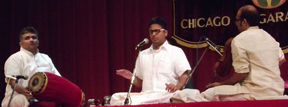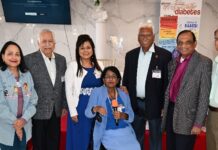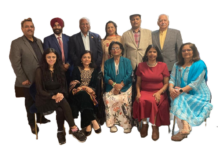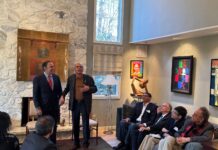
CHICAGO: Well-known Carnatic vocalist Bharat Sundar delivered the finale of the three-day annual Thyagaraja Festival (TF), dedicated to the saintly musician-composer, here at Hindu Temple of Greater Chicago on May 25.
He was accompanied by V.V.S. Murari on violin, Trivandrum Balaji mridangam and K.V.
Gopalakrishnan kanjira (tambourine). They were introduced by TF founder, professor TES Raghavan.
The concert began with “Padavini Sadbhakti” in ragam Saalagabhairavi set to Adi tala which ended in note improvisation (swara kalpana). For Thyagaraja’s “Amma Raavamma” in ragam Kalyani, Sundar delineated the musical variations on the lyrics (neraval) “taamarasa-dala netri” starting in slow tempo, highlighting key ornamentations (gamaka) with subtle beauty, thereby evoking a calm and soothing atmosphere.
His approach of developing the neraval at different defining (vaadi) swaras of Kalyani, such as nishada (ni), gandhara (ga) and rishabha (ri), and doing so continuously at a single stretch in fast tempo, amazed the audience. So did his command over the rhythm, when he sang the various permutations of improvisatory sol-fa notes (kalpana swara) within the rhythmic framework (tala).
“Korapu” is a challenging technical feat, where the artiste exhibits his virtuosity in swara-kalpana by gradually compressing the cycle (aavartanam), drawing on his musical experience and imagination to reach the “muktayam” or climax. Their korapu and swara-kalpana drew great applause.
Thyagaraja’s “Paramatmudu velige” in ragam Vagadhiswari and “Sarasa sama daana” in Kapi-narayani followed, the latter well rendered with kalpana swaras. Ragam Pantuvarali was explored in fervent detail in the alapanam for “Appa Rama Bhakti Yento,” with the violin meeting the challenge here and also in the kalpana swaras.
Neraval was rendered for the lyrics “Lakshmi devi valachuna” of the melodious opening lines (charanam) with breathtakingly fast progression of notes. “Sri Tulasamma Ma inta” followed in ragam Devagandhari.
The piece de resistance was “Koluvai yunnade” in the majestic ragam Bhairavi, the slow tempo facilitating his exploration of its beautiful nuances. With chatusruthi dhaivatha (note ‘dha’) in the ascent and shuddha dhaivata in descent, Bhairavi demands a good command over the swara-sthanas (underlying notes of the musical scale) and ornamentations (gamaka) and Sundar handled the raga with great fluency.
He portrayed the various facets of the raga, easily traversing the three octaves. Murari followed him with the same ease and perfection. Melody and rhythm peaked in the kalpana swaras for the lyrics “charana manasu.” This was followed by an extended percussion-only exchange (tani aavartanam) between Balaji and Gopalakrishnan, who displayed their expertise in rendering the different patterns of intricate jathis with perfection and to much applause.
Following a Tamil song “Ramanai Bhajittal” in ragam Maand, Bharat sang Purandhara Dasa’s “Jagadoddharana” in Kapi before concluding with Maharaja Swathi Tirunal’s famous Hindi Tillana (brisk dance item) in ragam Dhanashri.
Dr Jaishree Prasad






